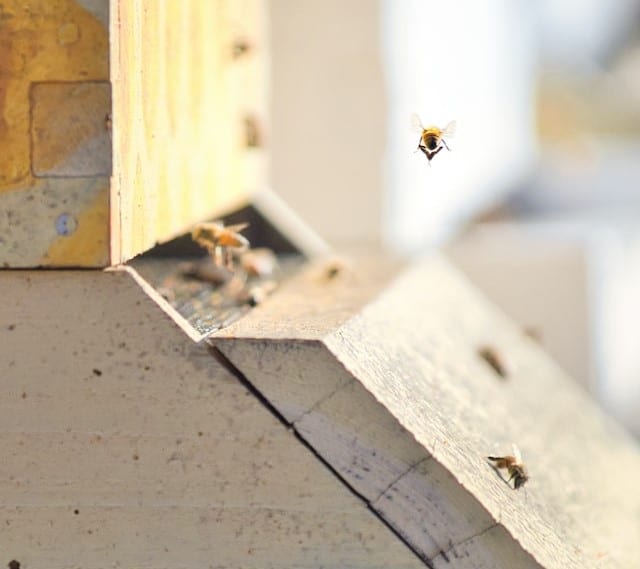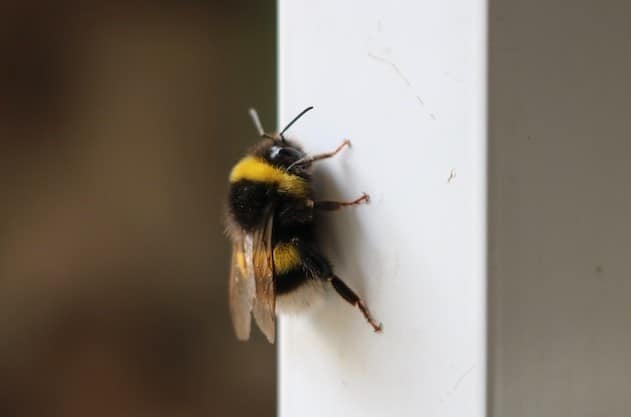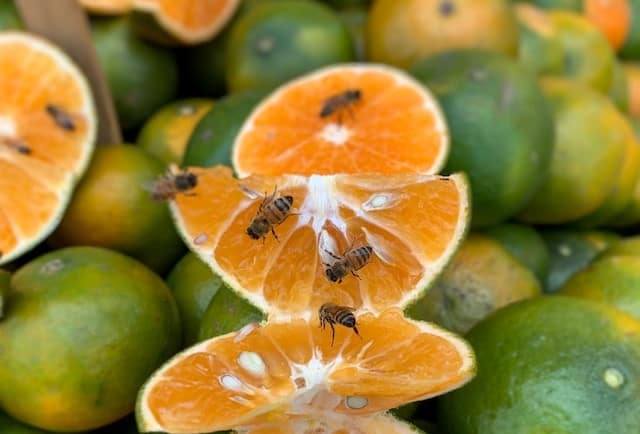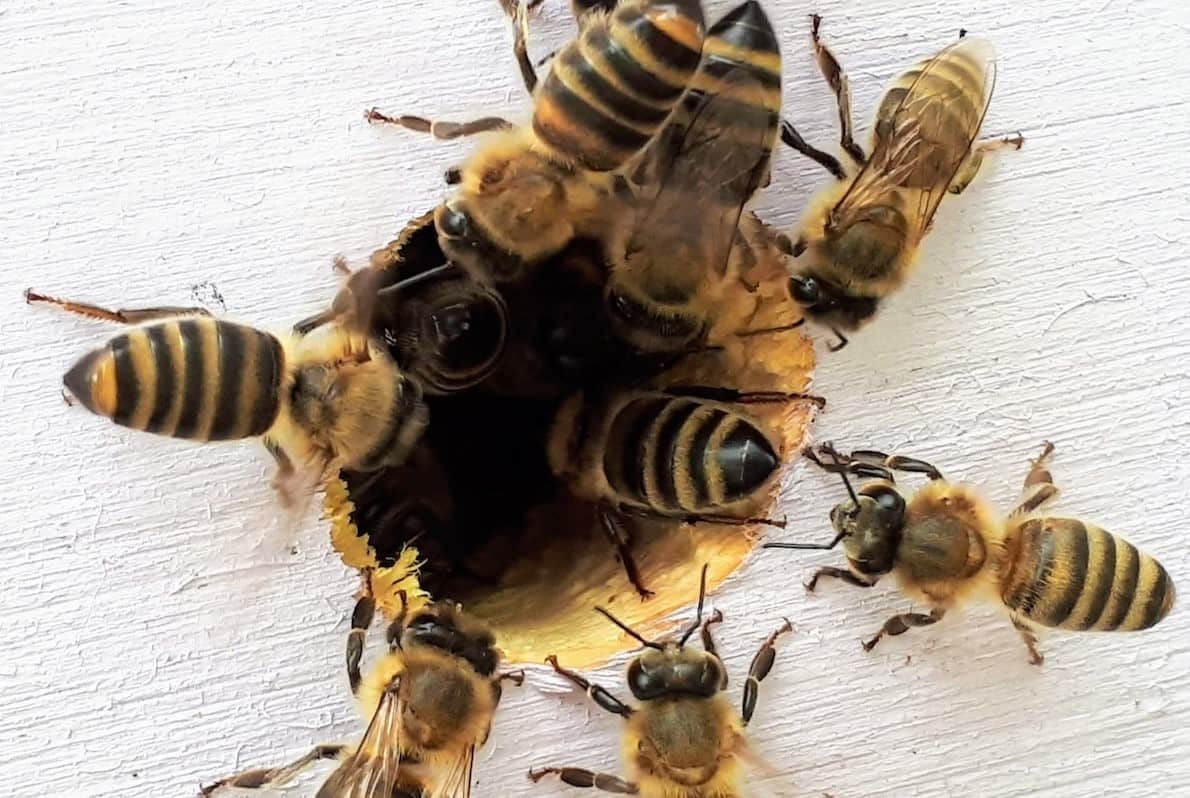Can you imagine living in your home and, at any moment, a bee attacks you because a colony lives in your walls?
The fact that these bees live inside your home could definitely break your peace of mind.
Educate yourself in knowing when there are bees in your walls.
Here are a few signs that would tell you that there are bees within your walls.
6 Signs that Tell You Bees and Wasps Are in Your Walls

1.) Bees and wasps flying out of wall crevices
Of course, one telltale sign that would tell you that bees or wasps have put up their residence within your walls is their presence coming in and out of wall crevices. Enhanced bee activity means a wasp nest or a bee hive is definitely in your walls.
If you see insects bearing some pollen on their bodies, then they definitely are bees. On the other hand, if you see one that may look like a bee but without a hairy body or with no pollen, then it could be a yellow jacket or some other wasp.
It is important to know the difference, as wasps are less beneficial than bees. Some wasps are also more aggressive than bees, and their presence around you and your kids could cause some painful experiences.
2.) Lots of buzz
Ain’t it obvious? When there’s a buzz, there’s a bee. So a lot of buzzes would mean more than the average number of bees (or wasps).
When you hear bees buzzing on your wall, chances are bees have taken up residence within. The stronger the buzz, the larger the colony.
A small colony would not be able to cause that much of a buzzing that could penetrate outside the walls. Unless, of course, the walls are too thin that even the slightest buzz can be heard across the room.
When you have thick walls, but still the buzzing sound is too discernible, you can be sure that there is a bee or wasp infestation within your house.

3.) Presence of bees inside the house
The presence of bees inside the house could also be an indication that there are bees living within your wall. This is especially true when you have your doors and windows closed, yet bees are buzzing around your house.
While it may be an incidental occurrence that one bee got trapped inside before the windows were closed, it might be more logical to conclude that a bee is inside because it lives in the walls inside your house.
A single bee might be a solitary incidence. However, it could also be a sign that there is an infestation within.
When this is the case, it is best to monitor the bee’s movement and find out where it resides. A bee crawling in crevices can help show us if there is a hive that you need to address.
4.) Exorbitant number of bees
An excessive number of bees flying in or around your house is definitely an indication that there is a bee infestation nearby. And it could very well be within your home.
This scenario could be quite a bother for many who are not at ease with the presence of bees. It could be a serious threat for those who suffer from allergies and are wary of bee stings.
5.) Finding an active Hive or nest
Finding an active nest around or inside your house is also an indication there may be bees crawling inside your walls.
An active nest on your wall is surely an indication that there are bees living on your walls. But there is more to this than this basic deduction.
As we all know, bees swarm and go off to another territory to establish another colony. If the hive or nest is near your house, it is very possible that a swarm may be on its way (if they have not yet) to establish residence on your walls.

6.) Dark spots on the walls
Dark patches on your walls could be indications of bee infestation. These dark spots are caused by the honey that these bees love to produce. When honey seeps out, it can cause a stain on your wall that will eventually turn dark.
While this may not be a cause of concern when you have a concrete wall, it can quite be a concern for those who have wooden structures on their walls.
Honey is a liquid that can slowly deteriorate wood. At the same time, honey attracts other insects and pests that can cause more damage to the walls.
What Kind of Bees Makes Nests in Walls?
Due to the similarity of yellowjackets and honeybees, many people have reported bee infestation, instead of wasp infestation, when they see a striped yellow and black insect in their homes. However, bee infestations at home are less prevalent than wasp infestations.
The Iowa State University shared in a post that around 90% of reported house wall infestations are not caused by bees but by wasps, specifically the yellowjacket wasp.
The remaining 10% are bee infestations caused by bumble bees, honey bees, mason bees, sweat bees, and carpenter bees.
What to do if you Have Bees on your Walls?
We all know that bees living inside your house are a potential threat, besides being a nuisance in the first place. For those suffering from bee allergies, the mere presence of these bees can cause uneasiness. And over time, bee infestation within your house can cause structural damage.
However, there is no hard and fast rule on how to get rid of a wasp or bee infestation. While the most obvious course to take is to remove their nests/hives, it may not be true in other cases and may not be safe for some.
But the first thing every homeowner should do before bee removal is to identify whether the insects are wasps or bee species. It will help in assessing what intervention is needed. There are specific processes to observe depending on the type of bee or wasp you have at home.
For Yellowjackets

Prior to thinking of ways to remove a yellowjacket’s nest at home, it is best first to observe this insect’s life cycle.
Queen yellowjackets leave their nests after mating. They find a secluded place to hibernate. The old queen and all the other yellowjackets in the old hive will die over the winter.
New queens will emerge in the spring, but they are not likely to establish residency in the old nests. Yellowjackets are not known to stay in old nests.
After the winter, the yellowjackets would most likely not be there anymore. If a new queen has put up residence, then it may be time to contact a pest control service company to do the job.
Remember, yellowjackets can sting you if they or their nests are threatened. So, avoid disturbing them unless you are a professional.
For Bumblebees
Bumblebees are ground bees, meaning these bees build their nests on the ground. But this does not stop them from building their homes in holes and cracks in walls too.
To prevent bees from using up spaces in your walls, seal every hole and crack with a Gorilla All Purpose Wood Filler, 16 Ounce Tub, Natural (Pack of 1) or a wall-mending solution like this.
For open vents, a screen vent like this would be sufficient to prevent these bees from entering.
Bees leave a mark on their territory. They leave behind a distinct scent that would signal other bees to come. Once a hive is removed from your home, discourage them from coming back.
This can be accomplished by cleaning the area where the bee hive used to be. Use a strong disinfectant to remove any scent.

For Honeybees
Removing a honeybee’s hive is a bit more difficult, and extra caution is needed. Remember, honey bees can be aggressive in defending their colonies. And honey bee venom can be serious and even life-threatening to one who has bee allergies.
If the bee infestation poses no immediate threat, it is best to leave it until late winter or early spring. This would be the best time to address this problem if you would pursue bee removal.
The help of beekeepers is needed in this situation. Let the beekeepers do the hive removal themselves, as they know best how to go about it with their vast experience in bee behavior.
In some cases, a beekeeper may use a bee vacuum to gather and remove the bees without killing them.
For Carpenter Bees
Carpenter bees are fond of burrowing in wooden structures. Hence, a wooden house is a good nesting place for these bees.
There are a few ways of getting rid of carpenter bees without killing them. In building your homes, it is best to use hardwood. Hardwood is hard to penetrate, and carpenter bees dislike spending too much time drilling on the hardwood.
When you already have bee holes in your wooden structures, cover these holes with bee corks and System Three 1600K20 SculpWood Putty Kit, 0.5 Gallon, Brown. After covering the holes, thoroughly paint the wood to deter these bees from returning.

For Sweat bees
Sweat bees thrive on rotting wood. Remove and replace rotten wood in your homes to deter these bees from living in your walls.
There are other ways of getting rid of sweat bees when they live on your property. Check out our more detailed post here on how to achieve this.
Other Options
In some cases, a beekeeper may need to open the wall to remove a hive or a nest.
Again, a bee vac is used to totally remove all bees without harming them. After the bees are safely tucked away and all the combs are removed, the area must be cleaned to remove the bees’ scent and keep them from returning.
Some beekeepers use a screen cone or bee valve to trap the bees safely away from their nesting site.
Beekeepers would use a beehive box near the entrance on the wall with a bee valve or a screen cone. Forager bees that went out would be directed to the beehive box upon their return.
After a few weeks, most of the bees would have been transferred to the beehive box. This would weaken the colony inside the walls, which could eventually die out.
Playing loud music is also believed to disturb the bees and their nests. Playing music at most times of the day can cause vibrations in the walls that would annoy these bees. Too much disturbance would signal these bees to move away.
Adding bee houses around your home is also an excellent way of encouraging bees to move out of your walls. A colony, over time, splits up to create another colony. Seeing bee houses around could be an attractive option for them.
Instead of building other nests or hives within your walls, they would move out to these ready-made houses for themselves. Who wouldn’t want to reside in a fully built place for free, eh?

Do Bees and Wasps Living in the Walls Cause Damage?
Aesthetically, bees and wasps living on your walls are not the greatest decors. In fact, they can be an annoyance to the eyes.
Structurally, these insects cause damage over time. When the honey is full, it tends to overflow and causes dark marks on your walls. When the temperature is high, wax can melt and also cause dark spots.
Along with the dark spots comes moisture from these flowing liquids. Moisture can cause a wooden wall to eventually rot.
Unused honey would ferment over time. When it does, it invites all kinds of insects and animals. Mice, rats, rodents, and other pests are tempted to get their share of this goodness.
Carpenter bees bore holes in wood. These bees drill holes in wooden decks, wooden boxes, and window sills, where they will eventually create nesting tunnels within. Too many nesting tunnels would create structural damage in these wooden structures.
How to Prevent Bees and Wasps from Getting in Your Walls
While the bees and wasps are not yet around, it is best to observe some practices that would not be an attraction for them.
Don’t leave your food uncovered
Yellowjackets are also known to be attracted to open soda bottles and food remains. So if you have a lot of these in your house, then they may be encouraged to stay. They may not live in their old nests, but there’s nothing stopping them from building another nest within your house, all the same.
Multiple bees and other wasps would not hesitate to swoop down on any sugary foods, so it is best always to cover leftover foods.
When the bees are used to not being able to get to your food, they might get the notion that they will never get any and move on and never return.

Grow bee-repellant plants
Beekeepers, farmers, and gardeners have shared that a few plants can help repel bees. Here are some of the plants that can help discourage bees from putting up residency in your house and in your walls:
- Red geraniums
- Marigolds
- Peacher Plants
- Mint
- Basil
- Lemon
- Wormwood
- Cucumbers
- Eucalyptus
Final Thoughts
Prevention is better than cure. So, before the start of wasps and bees buzzing inside your home, it is best to act quickly and ahead of them.
Avoid any bee problem by filling wall voids, holes, and cracks.
There would be no need for bee removal remedies if you plant flowers and herbs many bees find repelling to their sense of smell.
Provide a beehive nearby and at a safe distance from your house for them to lay eggs and grow more bees. A new hive would attract bee swarms to transfer residency.
Would you happen to know of other signs of bees in walls? Share it with us. We’d love to hear from you!
